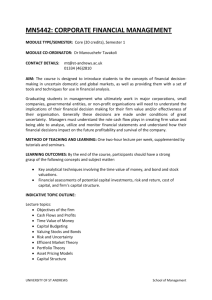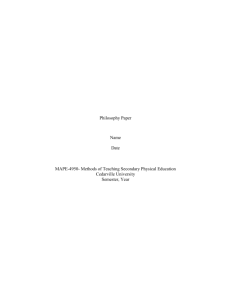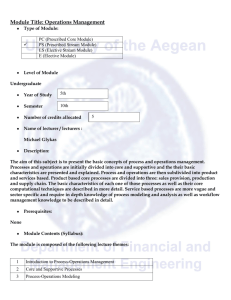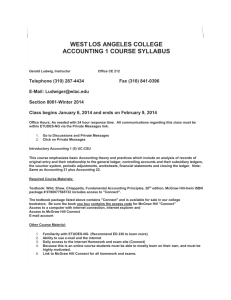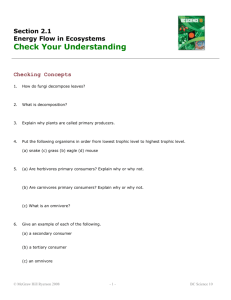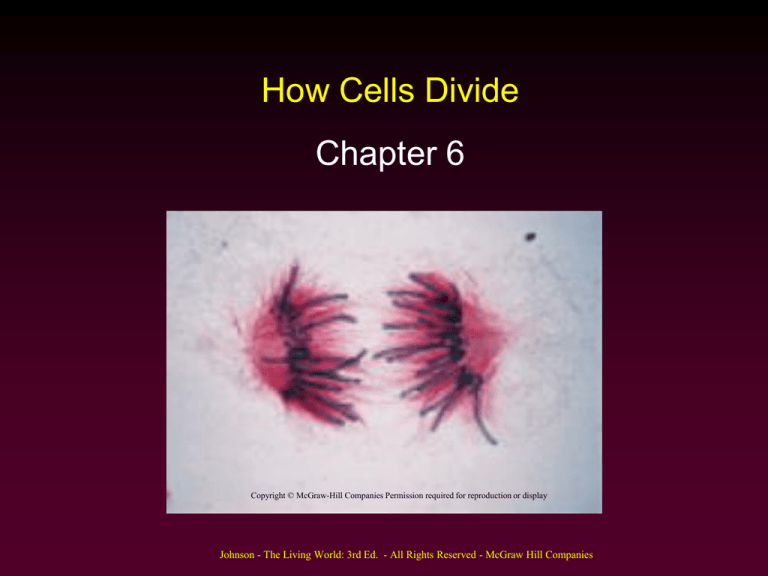
How Cells Divide
Chapter 6
Copyright © McGraw-Hill Companies Permission required for reproduction or display
Johnson - The Living World: 3rd Ed. - All Rights Reserved - McGraw Hill Companies
Outline
•
•
•
•
•
•
•
Simple Cell Cycle
Complex Cell Cycle
Chromosomes
Mitosis
Cancer
Meiosis I
Meiosis II
Evolutionary Consequences of Sex
Johnson - The Living World: 3rd Ed. - All Rights Reserved - McGraw Hill Companies
Simple Cell Cycle
•
•
Cell division in bacteria takes place in two
stages (Simple Cell Cycle).
DNA is copied
Cell Splits (Binary Fission)
- Forms two daughter cells
Heredity information in bacteria encoded in
single circle of DNA.
Copyright © McGraw-Hill Companies Permission required for reproduction or display
Johnson - The Living World: 3rd Ed. - All Rights Reserved - McGraw Hill Companies
Complex Cell Cycle
•
•
•
Eukaryotic DNA is contained in linear
chromosomes.
Long DNA molecules packaged with
proteins.
Mitosis - Mechanism of cell division occurring
in non-reproductive (somatic) cells.
Meiosis - Mechanism of cell division
occurring in reproductive (germ) cells.
Johnson - The Living World: 3rd Ed. - All Rights Reserved - McGraw Hill Companies
Complex Cell Cycle
•
•
•
•
•
G1 phase - Primary growth phase
S phase - DNA replicates
G2 phase - Microtubule synthesis
M phase - Chromosomes pull apart
C phase - Cytokinesis
Johnson - The Living World: 3rd Ed. - All Rights Reserved - McGraw Hill Companies
Complex Cell Cycle
Copyright © McGraw-Hill Companies Permission required for reproduction or display
Johnson - The Living World: 3rd Ed. - All Rights Reserved - McGraw Hill Companies
Chromosomes
•
Human cells each have 23 nearly identical
pairs of chromosomes, for a total of 46.
Each chromosome contains thousands of
genes that play important roles in body
development and function.
Copyright © McGraw-Hill Companies
Permission required for reproduction or display
Johnson - The Living World: 3rd Ed. - All Rights Reserved - McGraw Hill Companies
Chromosome Structure
•
DNA helix is wrapped around proteins with
positive charges (histones) and negative
charges counteracting each other.
Johnson - The Living World: 3rd Ed. - All Rights Reserved - McGraw Hill Companies
Chromosome Structure
•
•
Homologues - Nearly identical copies of the
same chromosomes.
Diploid Cells - Two copies of chromosomes.
Before cell division, each homologue
replicates, resulting in two identical copies
(sister chromatids).
- Remain attached at centromere.
Copyright © McGraw-Hill Companies
Permission required for reproduction or display
Johnson - The Living World: 3rd Ed. - All Rights Reserved - McGraw Hill Companies
Cell Division
•
•
Interphase - Chromosomes replicate and
begin to wind up tightly.
Mitosis
Prophase - Nuclear envelope breaks
down, DNA further condenses, and spindle
fibers form.
Metaphase - Chromosomes align at center
of cell and kinetochore fibers attach to
centromeres.
Johnson - The Living World: 3rd Ed. - All Rights Reserved - McGraw Hill Companies
Copyright © McGraw-Hill Companies Permission required for reproduction or display
Johnson - The Living World: 3rd Ed. - All Rights Reserved - McGraw Hill Companies
Mitosis
Anaphase - Centromeres replicate and
sister chromatids separate and move
towards opposite poles.
Telophase - Nuclear envelope reappears
and chromosomes decondense.
Johnson - The Living World: 3rd Ed. - All Rights Reserved - McGraw Hill Companies
Copyright © McGraw-Hill Companies Permission required for reproduction or display
Johnson - The Living World: 3rd Ed. - All Rights Reserved - McGraw Hill Companies
Cytokinesis
•
Cytokinesis - Division of cytoplasm.
Animal cells - Cell pinches in two with
contracting belt of microtubules, forming a
cleavage furrow.
Plant cells - Membrane assembled at right
angle to mitotic spindle. Cell plate grows
outward until it reaches the interior surface
of plasma membrane.
Johnson - The Living World: 3rd Ed. - All Rights Reserved - McGraw Hill Companies
Johnson - The Living World: 3rd Ed. - All Rights Reserved - McGraw Hill Companies
Controlling Cell Cycle
•
At critical points, further cell progress
depends on a central set of switches
regulated by cell feedback.
G1 – Cell growth assessed
G2 DNA replication assessed
M mitosis assessed
Johnson - The Living World: 3rd Ed. - All Rights Reserved - McGraw Hill Companies
Cancer
•
Cancer - Unrestrained cell growth and
division.
Tumor - Cluster of cells.
- Benign - Encapsulated and noninvasive.
- Malignant - Not encapsulated, invasive,
and shed cells.
Metastases - Process of cells
shedding from a malignant tumor and
spreading to distant parts of the body.
Johnson - The Living World: 3rd Ed. - All Rights Reserved - McGraw Hill Companies
Cell Cycle Control
•
Gene p53 plays a key role in G1 checkpoint
of cell division.
Gene’s product monitors integrity of DNA,
checking for successful replication.
- If protein detects damaged DNA, it halts
cell division and stimulates repair
enzymes.
Nonfunctional p53 genes allow cancer
cells to repeatedly divide.
Johnson - The Living World: 3rd Ed. - All Rights Reserved - McGraw Hill Companies
Curing Cancer
•
Preventing cancer from starting by focusing
on decision-making process to divide.
Receiving the signal to divide
Relay switch
Amplifying the signal
Releasing the brake
Checking that everything is ready
Stepping on the gas
Johnson - The Living World: 3rd Ed. - All Rights Reserved - McGraw Hill Companies
Curing Cancer
•
Preventing the Spread of Cancer
Tumor growth
- Angiogenesis inhibition
Metastasis
Johnson - The Living World: 3rd Ed. - All Rights Reserved - McGraw Hill Companies
Molecular Cancer Therapies
Johnson - The Living World: 3rd Ed. - All Rights Reserved - McGraw Hill Companies
Meiosis
•
Gamete formation must involve some
mechanism to halve the number of
chromosomes.
Two sets of chromosomes are present in
somatic cells of adults (diploid), but only
one set is present in gametes (haploid).
- Sexual Reproduction involves the
alteration of meiosis and fertilization.
Johnson - The Living World: 3rd Ed. - All Rights Reserved - McGraw Hill Companies
Alteration of Generations
Copyright © McGraw-Hill Companies
Permission required for reproduction or display
Johnson - The Living World: 3rd Ed. - All Rights Reserved - McGraw Hill Companies
Stages of Meiosis
•
Meiosis I
Prophase I - Chromosomes pair up and
exchange segments (Crossing Over).
Metaphase I - Chromosomes align at cell’s
center (Independent Assortment).
Anaphase I - Homologous pairs pulled
apart.
Telophase I - Individual chromosomes
gather at each of the poles.
Johnson - The Living World: 3rd Ed. - All Rights Reserved - McGraw Hill Companies
Crossing Over
Johnson - The Living World: 3rd Ed. - All Rights Reserved - McGraw Hill Companies
Meiosis II
•
Mitotic division involving products of Meiosis I.
Prophase II - Nuclear envelope breaks
down and spindle fibers form.
Metaphase II - Spindle fibers bind to both
sides of centromeres.
Anaphase II - Spindle fibers contract,
moving sister chromatids to opposite poles.
Telophase II - Nuclear envelope reforms
around four sets of daughter cells.
Johnson - The Living World: 3rd Ed. - All Rights Reserved - McGraw Hill Companies
Johnson - The Living World: 3rd Ed. - All Rights Reserved - McGraw Hill Companies
Johnson - The Living World: 3rd Ed. - All Rights Reserved - McGraw Hill Companies
Evolutionary Consequences of Sex
•
Genetic Diversity
Independent Assortment
Crossing Over
Random Fertilization
Copyright © McGraw-Hill Companies Permission required for reproduction or display
Johnson - The Living World: 3rd Ed. - All Rights Reserved - McGraw Hill Companies
Review
•
•
•
•
•
•
•
Simple Cell Cycle
Complex Cell Cycle
Chromosomes
Mitosis
Cancer
Meiosis I
Meiosis II
Evolutionary Consequences of Sex
Johnson - The Living World: 3rd Ed. - All Rights Reserved - McGraw Hill Companies
Copyright © McGraw-Hill Companies Permission required for reproduction or display
Johnson - The Living World: 3rd Ed. - All Rights Reserved - McGraw Hill Companies




